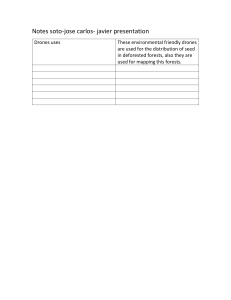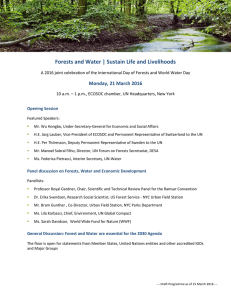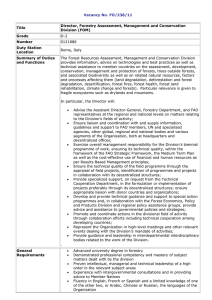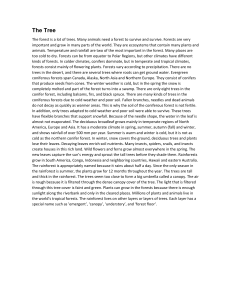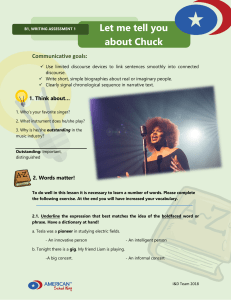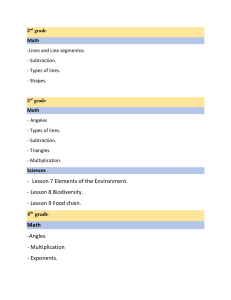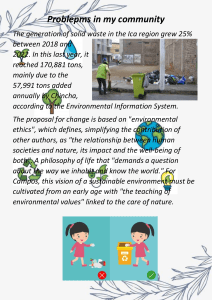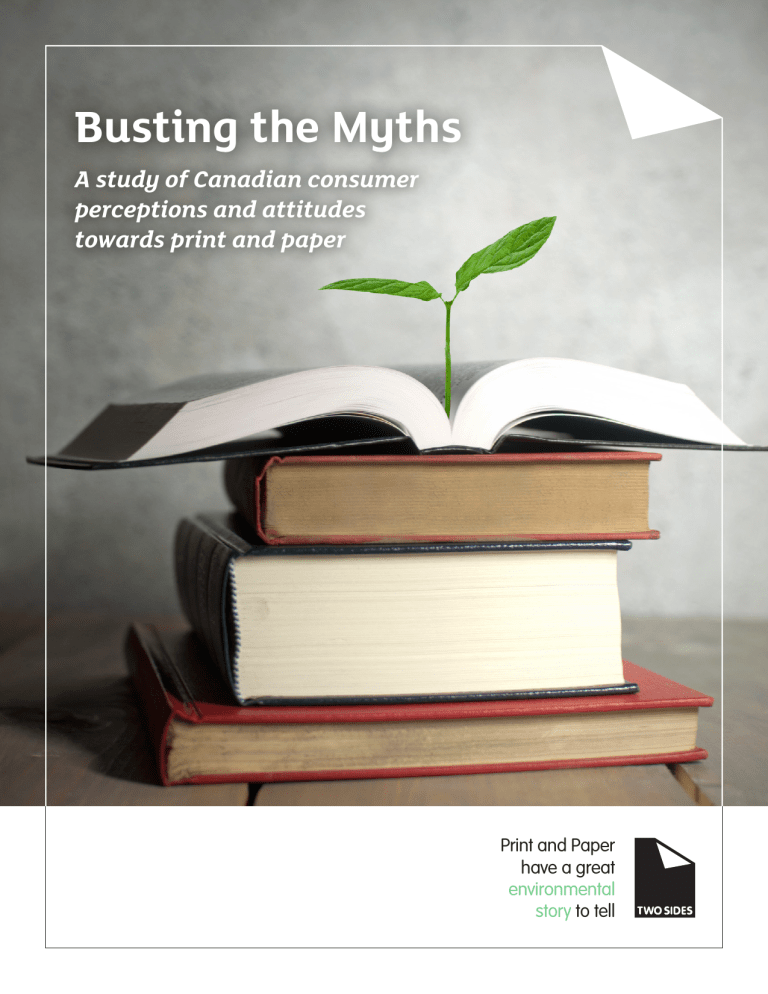
Busting the Myths A study of Canadian consumer perceptions and attitudes towards print and paper Print and Paper have a great environmental story to tell www.twosides.info INTRODUCTION INTRODUCTION A survey of 1,044 Canadian consumers was commissioned by Two Sides and carried out by independent research company Toluna in February 2019. 2. Introduction This report explores consumer opinions and beliefs about print and paper’s environmental impact; preferences related to reading in print versus digitally; and receiving paper or electronic communications from their service providers. 4. Understanding Forests 3. Key Findings 5. Circular by Nature 6. A Matter of Choice 7. Busting the Myths 8. References Phil Riebel President, Two Sides North America, Inc. We are pleased to present our latest consumer research which reveals many interesting insights into consumer attitudes towards print and paper. Survey results show that there are still significant gaps between consumer perceptions and actual fact when it comes to environmental topics such as forestry and recycling. Canadian consumers maintain a considerable preference for print when reading books and magazines. They also strongly value their right to choose paper communications from their banks and other service providers. The results presented below provide useful information in support of print and paper, and they identify great opportunities for further public education. We hope you find this report informative. About Two Sides Two Sides is a global initiative by companies from the Graphic Communications Industry including forestry, pulp, paper, inks and chemicals, pre-press, press, finishing, publishing, printing, envelopes, and postal operators. Our common goal is to promote the sustainability of the Graphic Communications Industry and dispel common environmental misconceptions by providing users with verifiable information on why print and paper is an attractive, practical and sustainable communications medium. Contact Two Sides If you would like to learn more about this report or find out about the many other tools and resources produced by Two Sides, please contact us. 855-896-7433 [email protected] www.twosidesna.org Twitter: @TwoSidesNA Facebook: @TwoSidesNorthAmerica Two Sides Report: Busting the Myths about Print and Paper (Canada) 2019 2 KEY FINDINGS FINDINGS KEY FINDINGS •• •• Receiving paper bills and statements Receiving paper bills and statements •• 82% of Canadian consumers believe they 82% of Canadian consumers believe they should have the right to choose how they •• •• should have the right to choose how they receive communications. Age group differences receive communications. Age group differences are shown in the graph to the right. are shown in the graph to the right. 80% believe they should have the right to 80% believe they should have the right to revert to paper options after choosing digital revert to paper options after choosing digital products or services. products or services. 66% believe they should not be charged more 66% believe they should not be charged more for choosing a paper bill or statement. for choosing a paper bill or statement. www.twosidesna.org / @TwoSidesNA / [email protected] www.twosidesna.org / @TwoSidesNA / [email protected] 35 - 44 35 -olds 44 Year Year olds 45 - 54 45 -olds 54 Year Year olds 55 and55over and over Canada Canada Average Average 18 - 24 18 -olds 24 Year Year olds 25 - 34 25 -olds 34 Year Year olds Books Books 45 - 54 45 -olds 54 Year Year olds Magazines Magazines 55 and55over and over Canada Canada Average Average 49% 49% 35 - 44 35 -olds 44 Year Year olds 46% 46% 80% 80% 70% 70% 60% 60% 50% 50% 40% 40% 30% 30% 20% 20% 10% 10% 0% 0% 68% 68% 59% 59% Percentage of consumers who prefer to read in print Percentage of consumers who prefer to read in print 70% 70% 65% 65% 57% 57% and 49% prefer printed newspapers. Age group and 49% prefer printed newspapers. Age group differences for reading preferences are shown differences for reading preferences are shown in the graph to the right. in the graph to the right. 52% are concerned the overuse of electronic 52% are concerned the overuse of electronic devices could be damaging to their health. devices could be damaging to their health. 46% believe they spend too much time on 46% believe they spend too much time on electronic devices. electronic devices. 25 - 34 25 -olds 34 Year Year olds 21% 21% 15% 15% 66% 66% 60% 60% •• 68% of consumers believe print is the most 68% of consumers believe print is the most enjoyable way to read books. enjoyable way to read books. •• 59% find printed magazines most enjoyable 59% find printed magazines most enjoyable 18 - 24 18 -olds 24 Year Year olds 25% 25% 67% 67% 56% 56% 47% 47% Reading Preferences (Print vs. Digital) Reading Preferences (Print vs. Digital) 12% 12% 42% 42% •• 17% 17% 71% 71% •• 26% 26% 57% 57% •• cause of global deforestation, behind urban development (first) and construction (second). development (first) and construction (second). However, pulp and paper is not a cause of forest However, pulp and paper is not a cause of forest loss in Canada due to long-term sustainable loss in Canada due to long-term sustainable forest management as a result of government forest management as a result of government regulations and forest certification programs. regulations and forest certification programs. Only 21% of consumers think the paper Only 21% of consumers think the paper recycling rate in Canada exceeds 60% (it is recycling rate in Canada exceeds 60% (it is actually 70%!). Results by age group are shown actually 70%!). Results by age group are shown in the graph to the right. in the graph to the right. When compared to 8 commonly used products When compared to 8 commonly used products and materials, wood is considered the most and materials, wood is considered the most environmentally friendly material, followed by environmentally friendly material, followed by paper and then glass. paper and then glass. Plastic is considered to be the least Plastic is considered to be the least environmentally friendly material, followed environmentally friendly material, followed closely by electronic devices. closely by electronic devices. 30% 30% 25% 25% 20% 20% 15% 15% 10% 10% 5% 5% 0% 0% 54% 54% •• Canadians rank pulp and paper as the third key Canadians rank pulp and paper as the third key cause of global deforestation, behind urban 39% 39% 35% 35% Environmental Perceptions Environmental Perceptions Percentage of consumers who believe the paper Percentage of consumers who believe recycling rate in Canada exceeds 60%the paper recycling rate in Canada exceeds 60% Newspapers Newspapers Percentage of consumers who believe they should have Percentage of consumers whoreceive believecommunications they should have the right to choose how they the right to choose how they receive communications 100% 100% 90% 90% 80% 80% 70% 70% 60% 60% 50% 50% 40% 40% 30% 30% 20% 20% 10% 10% 0% 0% 89% 89% 72% 72% 74% 74% 18 - 24 18 -olds 24 Year Year olds 25 - 34 25 -olds 34 Year Year olds 80% 80% 79% 79% 35 - 44 35 -olds 44 Year Year olds 45 - 54 45 -olds 54 Year Year olds 55 and55over and over 82% 82% Canada Canada Average Average 3 3 UNDERSTANDINGFORESTS FORESTS UNDERSTANDING The Canadian pulp and paper industry depends on sustainable forest management to provide a reliable supply of wood fibre - the key raw material for its products. Well-managed forests bring multiple benefits for society, such as employment, social and recreational opportunities, and environmental benefits such as carbon storage, water protection and biodiversity. At 0.02% of its forested area, deforestation in Canada is among the world’s lowest. The key causes of deforestation are not forestry but rather urbanization, agriculture, hydroelectric and other developments such as oil and gas. Forestry regulations require mandatory regeneration on all Crown (public) lands in Canada so that harvested areas continue to produce forests for the long term.1 What do you believe has been happening to the size of Canada’s forest area since the year 2000? Despite the importance of these certifications to the paper supply chain and wider forest products industries, the survey found that only 20% of Canadian consumers are aware of FSC® or SFI. Agriculture is the main cause of deforestation globally,3,4 yet the survey found that consumers believe this activity to have the least impact on forests. Pulp and paper ranked third among six choices (see figure below). % 17 2 6% 2% When it comes to paper purchasing behaviour, 70% of Canadian consumers believe it is important to use paper products from sustainably managed forests. However, only 22% pay attention to forest certification labels when purchasing paper. Which industry/ activity do you believe has the most impact on forests? 1 being little impact, and 5 being the most damaging impact. AGRICULTURE 55% Growing in size Staying about the same 2.9 PALM OIL PLANTATIONS Reducing in size Don’t know/ unsure Although Canada’s forest area has remained relatively stable for many decades (slight decrease as mentioned above), 55% of Canadian consumers were correct in responding that Canada’s forests are decreasing in size. Forest certification to independent third-party standards promotes forest management practices that result in outcomes that are economically viable, ecologically sound and socially just. Globally, a total of 1.06 billion acres are certified under the Programme for the Endorsement of Forest Certification (including the Sustainable Forestry Initiative or SFI) and the Forest Stewardship Council® (FSC®). Although only about 10% of the world’s forests are certified, half of them are in North America.2 Since it emerged in the 1990s, forest certification has been adopted quickly across Canada, and now more than 48% of the country’s forests are certified. At the end of 2016, Canada had 168 million hectares (415 million acres) of independently certified forest land. That represents 37% of all certified forests worldwide, the largest area of thirdparty-certified forests in any country.1 Two Sides Report: Busting the Myths about Print and Paper (Canada) 2019 3.2 ENERGY/ WOODFUEL 3.3 PAPER AND PULP 3.4 CONSTRUCTION 3.5 URBAN DEVELOPMENT 2.0 2.2 2.4 2.6 2.8 3.7 3.0 3.2 3.4 3.6 3.8 4.0 Harvesting wood for forest products is not considered deforestation due to natural or artificial regeneration (re-planting). Each Canadian province has its own regeneration standards and regulations, addressing such areas as species composition, density and stocking levels, and distribution of various forest types across the landscape.1 When considering the world’s wood harvest, 50% is used for fuel and over 30% is processed for other industrial uses, such as construction and furniture. There are other uses, including 13% used by the paper industry.5 4 CIRCULARBY BYNATURE NATURE CIRCULAR The ability to easily collect and recycle a product – for both consumers and industry – is critical to a circular economy. The overall recovery rate for paper and paper-based packaging is 70%, making Canada among the top paper recycling countries in the world.6 Overall recovery rates above 75% are difficult to achieve because a portion of paper products cannot be recovered due to damage or contamination when used (e.g. paper towels and tissue), and others are kept for long periods of time (e.g. books and archived documents).7 The survey found that Canadian consumers perceive paper to have the highest recycling rate among five common materials and products (see Figure below), although only 20% of consumers are aware that the paper recycling rate exceeds 60%. In 2016, paper made up the largest portion of material diverted from landfill (39% of the total amount of waste), followed by organic materials (28%) and the least diverted was plastic at 5%.8 Yet 10% of consumers believe that up to 59% of plastic is recycled and a further 14% believe the plastic recycling rate is over 60%. This is because at least 15% of paper products are permanently removed from the fiber cycle as mentioned above. In addition, fibers break down during the recycling process and can only be re-used 5 to 7 times at most.9,10 Globally, recovered paper is the most important papermaking fiber raw material and makes up over 56% of fiber used by the pulp and paper industry.11 In your opinion, what is the environmental impact of following materials/ products? Please rate from 1 – 5, with 1 being the least environmental impact and 5 being the greatest impact. (Graph shows mean score). What percentage of the following products do you think is recycled in Canada? S- 5% 17% 14% 25% ON E L E C T R 3. 7 7 CPLA STI 5% 0% 3 CE 34% 16% 12% 10% 14% 15% 26% 34% 22% 21% 20% 24% 28% 25% 26% 32% 32% 30% 37% 38% 35% O WO R E P 2 PA S - .0 S A GL 3 L - 3. 2 META ICS 8 C E R A M - 3. 2 E VI E D T E X TIL IC 41% 40% Paper 0 - 19% Glass 20 - 39% Metal Plastic 40 - 59% 8 45% 3 .4 D - 2 - 2.5 6 .9 . 7 4 6 3 50% Electronic Devices Over 60% Canadians ranked wood as the most environmentallyfriendly material out of a list of several common products and materials, closely followed by paper and then glass (see figure above). Plastic was ranked as being the least environmentallyfriendly followed by electronic devices (laptops, desktop computers, smartphones, tablets and e-readers). 56% of consumers surveyed believe only recycled paper should be used. In reality, a continual input of 35% to 65% of fresh wood fiber (from sustainably managed forests) is needed to make the global papermaking cycle work depending on the grade of the paper manufactured. www.twosidesna.org / @TwoSidesNA / [email protected] 5 MATTEROF OFCHOICE CHOICE AA MATTER In today’s digital world, the power of print on paper is becoming more apparent than ever. Consumers throughout Canada prefer reading in print, with many understanding the importance of “switching off” their digital devices. Consumers also feel strongly about their right to receive paper statements and bills from their banks, governments and other service providers. Efforts by corporations to save costs and push their customers to go digital, often citing environmental claims, do not reflect the preferences and opinions of many consumers. Although only 27% of the survey respondents feel they are suffering from “digital overload”, there is a clear preference among Canadians to enjoy the offline world, with 68% believing in the importance of “switching off” and reading more in print. Print is also considered an enjoyable way to read books (68%), magazines (59%) and newspapers (49%). Which format is the most enjoyable way to read... BOOKS 68% 22% MAGAZINES 59% NEWSPAPERS 49% 0% 11% 30% 32% 20% In Print 40% 60% Don’t mind 11% 18% 80% an consume anadi rs b of C eli ev et e they sh v e i l e h b oul % dh 80 av e 66% be lie v are concerned the overuse of electronic devices could be damaging to their health % 82 believe they spend too much time on electronic devices 52% 100% Electronically Financial institutions, utility companies, telecoms and governments are increasingly encouraging their customers to go “paperless”, often citing environmental claims about paper (ex: go green, save trees). However, 58% of Canadian consumers believe the real motivation behind the drive to digital is to save costs. Switching to digital is not always welcome, as many consumers need or prefer paper-based communication. Two Sides Report: Busting the Myths about Print and Paper (Canada) 2019 nts me te 46% ight to cho e the r ose hav ho d l w u o th t r e t o v e p r sh ey a o per t t y h o e g p i r tio e n th ould not be y sh ch he t a r e cations muni com ive g digital ce oosin re r ch fte aper bills an sa or p ds df ta ge 46% of Canadian consumers believe they spend too much time on electronic devices, and over half (52%) are concerned that the overuse of electronic devices could be damaging to their health. Overall, 82% of Canadian consumers believe they should have the right to choose how they receive communications (printed or electronically) from financial organizations and service providers. 80% believe they should have the right to revert to paper-based communications even after switching to digital and 66% believe they should not be charged more for choosing paper bills and statements. Giving customers fair, easy and free access to paper billing is especially important when considering the benefits print brings to financial literacy. Almost half (49%) of consumers find it easier to manage their finances when printed on paper. 67% of respondents are concerned that their personal information held electronically is at risk of being hacked, stolen, lost or damaged. These doubts about cyber security may also explain why 67% keep hard copies of important documents filed at home, as they believe this is the safest and most secure way of storing their information. Service providers should also consider the risk they take when switching their customers to digital without consent. About one third (34%) of consumers would consider switching to an alternative service provider if they were forced to go paperless. 6 BUSTINGTHE THEMYTHS MYTHS BUSTING TH M YT H 57% TH E believe electronic communication is better for the environment M YT • In most developed countries, such as Canada, forestry is not considered deforestation because regulations require mandatory regeneration so that harvested areas continue to produce forests for the long term.1 • Globally the key cause of deforestation is the conversion of forest land to agriculture and livestock areas.12 THE FACTS M TH THE FACTS E H YT H 36% believe paper is a wasteful product E YT TH M Pulp and paper is a key cause of global deforestation E TH E When it comes to the sustainability of print and paper, it’s important to separate the facts from myths. The Canadian pulp and paper industry has made great strides when it comes to sustainably sourced raw materials, renewable energy use and paper recovery rates. However, many myths about paper and its impact on the environment are prevalent among consumers. M YT THE FACTS • Paper is one of the most recycled materials with 70% of paper being recovered in Canada. • In Canada, 87% of the fiber used to make paper comes from sawmill residues (59%) and recycled paper (28%). 15,16 H 26% believe paper production is a major cause of global GHG emissions • The information and communications technology (ICT) industry accounts for around 2.5-3% of global GHG emissions and this is predicted to rise to 14% by 2040.13 • Smartphones accounted for 435,000 tonnes of e-waste in 2016.14 THE FACTS • The pulp, paper and print industry is one of the lowest contributors to the global greenhouse gas inventory with 1% of total global GHG emissions.17 • The Canadian forest products industry has eliminated the use of coal and cut oil use by more than 90% since 2000.18 Bioenergy is increasingly used to generate electricity, accounting for 57% of industry’s energy use in 2015.1 H 56% believe only recycled paper should be used THE FACTS • Wood fiber from well managed forests is essential to papermaking because recycled fiber breaks down after each use and can only be re-used 5-7 times. • Without a continual input of wood fiber, the global paper cycle would stop in 6 to 18 months depending on the paper grade.9 www.twosidesna.org / @TwoSidesNA / [email protected] FIND OUT MORE Version 4 of Two Sides’ Myths & Facts booklet is now available. Download the booklet here: www.twosidesna.org/myths-and-facts-booklet Or request a free printed version: [email protected] Members of Two Sides have exclusive permission to personalize and co-brand the booklet, as well as all other Two Sides materials. For more information, please get in touch: 855-896-7433 / [email protected] 7 1. Natural Resources Canada, 2018. The State of Canada’s Forests. http://cfs.nrcan.gc.ca/pubwarehouse/pdfs/39336.pdf PEFC, 2018. Facts and Figures. United Nations Food and Agriculture Organization, 2016. State of the Forests 2016. FoodWorld’s and Agriculture Organization of the United Nations Forests. (FAO), Natural Resources Canada, 2018. The State of Canada’s Hosonuma etForest al., 2012. https://iopscience.iop.org/ 2015. Global Resources Assessment 2015. http://cfs.nrcan.gc.ca/pubwarehouse/pdfs/39336.pdf article/10.1088/1748-9326/7/4/044009 Programme for the Endorsement of Forest Certification PEFC, 2018. and Figures. Derived fromFacts FAOSTAT, 2018 Forest Stewardship Council. United Nations Food and Agriculture Organization, 2016. State of Forest Products of Canada, 2015. http://www.fpac.ca/wpPEFC. 2018. FactsAssoc. and Figures. the World’s Forests 2016. content/uploads/FPAC_Environmental_Brochure.pdf American Forest &2012. Paperhttps://iopscience.iop.org/ Association, 2018. Hosonuma et al.,Recycling European Paper Council, 2018. Monitoring United Nations FAO, 2016. State of the World’s ForestsReport 2016. 2017. article/10.1088/1748-9326/7/4/044009 Government of Canada, 2018. https://www.canada.ca/en/ Derived from FAOSTAT, 2018. Derived from FAOSTAT, 2018 environment-climate-change/services/environmental-indicators/ www.paperrecycles.org. Forest Products Assoc. of Canada, 2015. http://www.fpac.ca/wpsolid-waste-diversion-disposal.html American Forest & Paper Association. content/uploads/FPAC_Environmental_Brochure.pdf Metafore 2006. American(now ForestGreenblue), & Paper Association, 2016. European Paper Recycling 2018. Monitoring Report 2017. Sappi North America, 2013.Council, European Paper Recycling Council, 2018. Monitoring Report 2017. Government of Canada, 2018. https://www.canada.ca/en/ Plastics Recycling Update, 2018. https://resource-recycling.com/ environment-climate-change/services/environmental-indicators/ plastics/2018/08/01/epa-u-s-plastics-recycling-rate-declines/ solid-waste-diversion-disposal.html REFERENCES 2. 3. 1. 1. 4. 2. 2. 5. 3. 3. 6. 4. 5. 4. 7. 6. 8. 7. 5. 8. 6. 9. 9. 10. 7. 10. 11. 8. 12. 9. 10. Metafore (now Greenblue), 2006. Sappi North America, 2013. For more information, please get in touch: For more information, please get in touch: 855-896-7433 [email protected] 855-896-7433 www.twosidesna.org [email protected] For more information, please get in touch: Twitter: @TwoSidesNA www.twosidesna.org 855-896-7433 Facebook: @TwoSidesNorthAmerica Twitter: @TwoSidesNA [email protected] Facebook: @TwoSidesNorthAmerica www.twosidesna.org Twitter: @TwoSidesNA 11. 12. Jaakko Poyry, 2015. World Fiber Outlook. Food and Agriculture Organization of the United Nations, 2018. The State of the World’s Forests. 13. Belkhir L. & Elmeligi A., 2018. Journal of Cleaner Production. ICT global emissions footprint: Trends to 2040 & 13. Assessing Metafore (now Greenblue), 2006. 11. Jaakko Poyry, 2015. World Fiber Outlook. recommendations. 14. Sappi North America, 2013. 12. Food and Agriculture Organization of the United Nations, 2018. The 14. Ellen MacArthur Foundation, 2018. 15. State Jaakko Poyry, 2015.Forests. World Fiber Outlook. ofProducts the World’s 15. Forest Association of Canada, 2012. http://www.fpac.ca/ 16. Belkhir World Business Council for Sustainable and NCASI, 13. L. & Elmeligi A., 2018. Journal of Development Cleaner Production. publications/FPAC-Recycling_and_Fibre_Cycle-White_paper_FINAL. 2007. Assessing ICT global emissions footprint: Trends to 2040 & pdf 17. Belkhir L. & Elmeligi A., 2018. Journal of Cleaner Production. 16. recommendations. Natural Resources Canada, 2014. http://cfs.nrcan.gc.ca/ Assessing ICT global emissions footprint: Trends to 2040 & 14. Ellen MacArthur Foundation, 2018. pubwarehouse/pdfs/35713.pdf recommendations. 15. Forestand Products Association of Canada, 2012. http://www.fpac.ca/ 17. ASN Ecofys, 2015 (2012 GHG data). 18. publications/FPAC-Recycling_and_Fibre_Cycle-White_paper_FINAL. Ellen MacArthur Foundation, 2018. 18. 2015. Growing greener 19. FPAC, ASN and Ecofys, 2015a(2012 GHGtomorrow. data). http://www.fpac.ca/wppdf content/uploads/FPAC_Environmental_Brochure.pdf 20. EPA, 2018. Pulp and paper emissions. 16. Natural Resources Canada, 2014. http://cfs.nrcan.gc.ca/ 21. pubwarehouse/pdfs/35713.pdf American Forest & Paper Association, 2018. 17. ASN and Ecofys, 2015 (2012 GHG data). 18. FPAC, 2015. Growing a greener tomorrow. http://www.fpac.ca/wpcontent/uploads/FPAC_Environmental_Brochure.pdf Print and Paper Print andaPaper have great have a great environmental Print and Paper environmental story to tell have a great story to tell www.twosides.info environmental www.twosides.info
